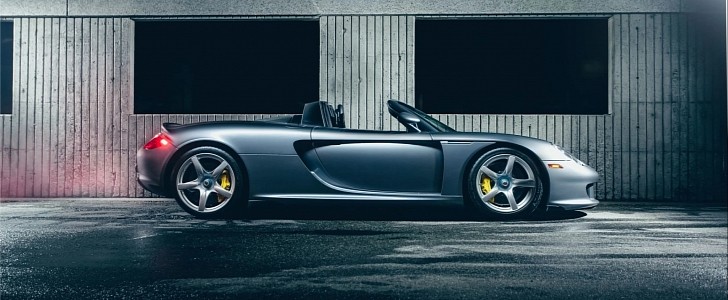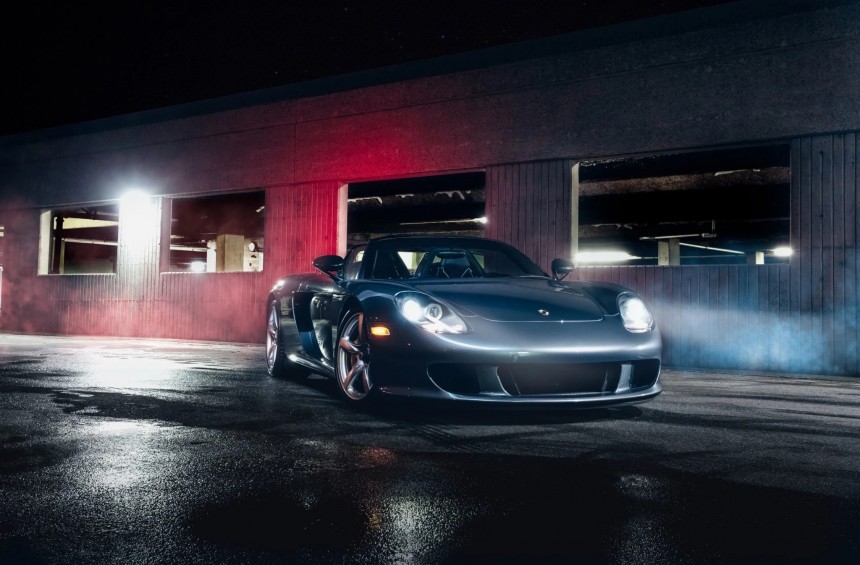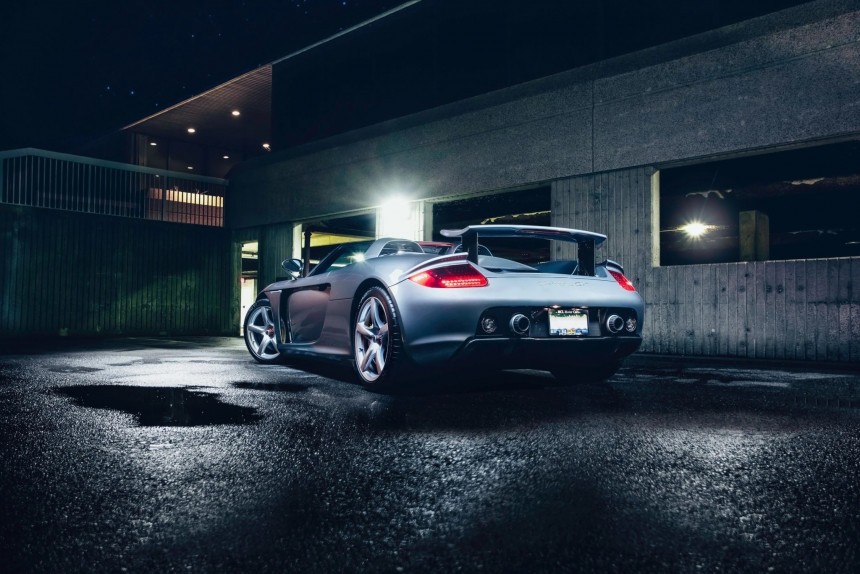The Carrera GT story begins with a 3.5-liter V12, the 3512 used by Footwork in the 1991 Formula 1 World Championship. Not powerful enough and so large and heavy that the FA12 open-wheeled racecar had to be redesigned around this lump, the free-breathing powerplant was immediately replaced with the DFV-based Cosworth DFR V8.
As this resounding failure was unfolding, the Stuttgart-based automaker was also developing a V10 for the 1992 season, a screamer of a powerhouse that eventually found its way under the hood of the LMP2000. Alternately known as the 9R3, this racecar never actually saw racing action to avoid on-track clashes with the R8, fielded by Volkswagen Group stablemate Audi.
After putting so much work into this engine, someone at Porsche had the brilliant idea to repurpose it for a road-going application. The successor of the 959 was already on the drawing board, and the concept would be presented in March 2000 at the Geneva Motor Show in Switzerland. To understand how fast the German automaker hopped from one project to another, bear in mind the LMP2000 program was sadly canned in May of 1999.
The concept rocked a 5.5-liter V10 from the Le Mans prototype, albeit slightly detuned for obvious reasons. Not long after, it was enlarged to 5.7 liters for much-needed oomph to fend off the likes of the Ferrari Enzo (6.0-liter V12) and Mercedes-Benz SLR McLaren (5.4-liter supercharged V8).
At long last, series production of the Carrera GT began at the Leipzig plant in early 2004. Exclusively offered in left-hand drive, the mid-engine masterpiece was initially limited to 1,500 examples worldwide. Come May 2006, the assembly line came to a screeching halt due to a change in airbag regulations in the United States of America. 1,270 copies were completed.
Internally referred to as Typ 980, the Carrera GT is motivated by the Typ 980/01 aluminum-alloy V10 with a 68-degree angle between the cylinder banks. Gifted with a 98-millimeter bore and 76-millimeter stroke, the motor uses Nikasil cylinder liners for minimum friction, variable valve timing on the intake side, and sodium-filled exhaust valves. Highlights further include forged titanium connecting rods, forged aluminum pistons, dry-sump lubrication, Bosch Motronic fuel injection, and a 12.0:1 compression ratio.
Typical of a race-bred engine, the 980/1 revs like nobody’s business. The 10-cylinder banshee redlines at 8,400 revolutions per minute, produces 603 horsepower (612 ps) at 8,000 rpm, and cranks out 435 pound-feet (590 Nm) at 5,750 rpm. The only transmission offered is a six-speed manual with a ceramic composite clutch that may feel unnatural to some drivers. A twin-plate design, this clutch should be let out slowly without applying any throttle before you get the feel for where it engages. A throttle cut-off system protects this tricky clutch from glazing when starting from a stop.
Tipping the scales at 1,380 kilograms (3,042 pounds), the CGT is lighter than the Enzo and much lighter than the McLaren-infused SLR that’s based on a grand tourer. Zero to 100 kilometers per hour (62 miles per hour) takes less than four seconds, and if you keep your foot planted on the loud pedal, the speedometer will indicate 330 kilometers an hour (205 miles an hour).
In the first year of production, the Carrera GT came with a beech wood gear knob that harks back to the balsa wood knob of the 917 racing cars from the 1970s. The following year, a carbon-fiber gear knob was offered. In keeping with racing tradition, the ignition is left of the three-spoke steering wheel.
No fewer than five body colors were offered, starting with GT Silver Metallic. The rest of the palette comprises Basalt Black, Seal Gray, Guards Red, and Fayence Yellow. Customers who preferred a unique finish had the opportunity of specifying a paint-to-sample color for quite a bit of moolah.
Fitted with bi-color nuts for the center-lock wheels, red on the driver side and blue on the passenger side, the Carrera GT wears yellow on its paint calipers to signify that it’s a carbon-ceramic affair. 380-millimeter discs and six-piston monobloc brake calipers are fitted on every corner of the CGT.
A carbon-fiber monocoque with a wheelbase of 2,730 millimeters also needs to be mentioned, along with 19- by 9.5-inch and 20- by 12.5-inch tires that were specially developed by Michelin for this application. Two fuel tanks with a total capacity of 92 liters (24.3 gallons) are fitted on either side of the engine, and the front track is 25 millimeters wider than the rear one.
The glorious Carrera GT was replaced in 2013 by the 918 Spyder, a plug-in hybrid that belts out 875 horsepower (887 ps) and 944 pound-feet (1,280 Nm) with the help of a twin-turbo V8 and a duo of electric motors.
After putting so much work into this engine, someone at Porsche had the brilliant idea to repurpose it for a road-going application. The successor of the 959 was already on the drawing board, and the concept would be presented in March 2000 at the Geneva Motor Show in Switzerland. To understand how fast the German automaker hopped from one project to another, bear in mind the LMP2000 program was sadly canned in May of 1999.
The concept rocked a 5.5-liter V10 from the Le Mans prototype, albeit slightly detuned for obvious reasons. Not long after, it was enlarged to 5.7 liters for much-needed oomph to fend off the likes of the Ferrari Enzo (6.0-liter V12) and Mercedes-Benz SLR McLaren (5.4-liter supercharged V8).
At long last, series production of the Carrera GT began at the Leipzig plant in early 2004. Exclusively offered in left-hand drive, the mid-engine masterpiece was initially limited to 1,500 examples worldwide. Come May 2006, the assembly line came to a screeching halt due to a change in airbag regulations in the United States of America. 1,270 copies were completed.
Typical of a race-bred engine, the 980/1 revs like nobody’s business. The 10-cylinder banshee redlines at 8,400 revolutions per minute, produces 603 horsepower (612 ps) at 8,000 rpm, and cranks out 435 pound-feet (590 Nm) at 5,750 rpm. The only transmission offered is a six-speed manual with a ceramic composite clutch that may feel unnatural to some drivers. A twin-plate design, this clutch should be let out slowly without applying any throttle before you get the feel for where it engages. A throttle cut-off system protects this tricky clutch from glazing when starting from a stop.
Tipping the scales at 1,380 kilograms (3,042 pounds), the CGT is lighter than the Enzo and much lighter than the McLaren-infused SLR that’s based on a grand tourer. Zero to 100 kilometers per hour (62 miles per hour) takes less than four seconds, and if you keep your foot planted on the loud pedal, the speedometer will indicate 330 kilometers an hour (205 miles an hour).
In the first year of production, the Carrera GT came with a beech wood gear knob that harks back to the balsa wood knob of the 917 racing cars from the 1970s. The following year, a carbon-fiber gear knob was offered. In keeping with racing tradition, the ignition is left of the three-spoke steering wheel.
Fitted with bi-color nuts for the center-lock wheels, red on the driver side and blue on the passenger side, the Carrera GT wears yellow on its paint calipers to signify that it’s a carbon-ceramic affair. 380-millimeter discs and six-piston monobloc brake calipers are fitted on every corner of the CGT.
A carbon-fiber monocoque with a wheelbase of 2,730 millimeters also needs to be mentioned, along with 19- by 9.5-inch and 20- by 12.5-inch tires that were specially developed by Michelin for this application. Two fuel tanks with a total capacity of 92 liters (24.3 gallons) are fitted on either side of the engine, and the front track is 25 millimeters wider than the rear one.
The glorious Carrera GT was replaced in 2013 by the 918 Spyder, a plug-in hybrid that belts out 875 horsepower (887 ps) and 944 pound-feet (1,280 Nm) with the help of a twin-turbo V8 and a duo of electric motors.



































































